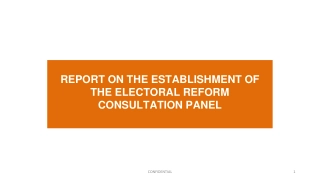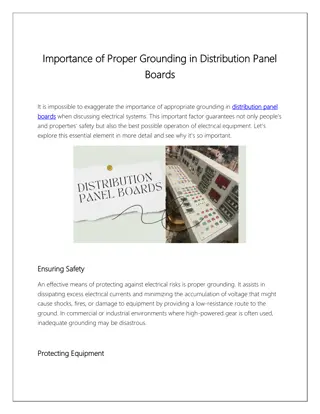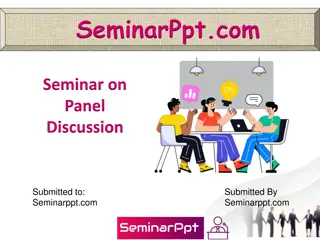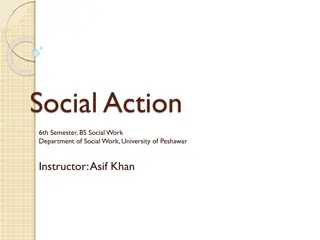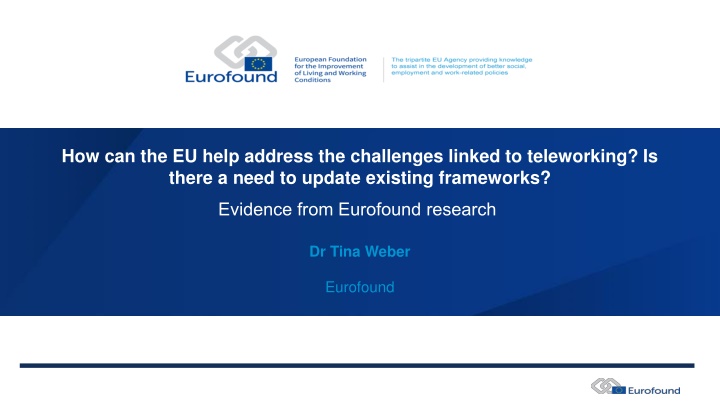
Addressing Challenges of Teleworking in the EU: Insights from Eurofound Research
Explore how the EU can help tackle teleworking challenges and update existing frameworks based on evidence from Eurofound research by Dr. Tina Weber. Discover insights on working patterns, effects on working time, teleworking during the pandemic, and post-COVID preferences regarding teleworking.
Download Presentation

Please find below an Image/Link to download the presentation.
The content on the website is provided AS IS for your information and personal use only. It may not be sold, licensed, or shared on other websites without obtaining consent from the author. If you encounter any issues during the download, it is possible that the publisher has removed the file from their server.
You are allowed to download the files provided on this website for personal or commercial use, subject to the condition that they are used lawfully. All files are the property of their respective owners.
The content on the website is provided AS IS for your information and personal use only. It may not be sold, licensed, or shared on other websites without obtaining consent from the author.
E N D
Presentation Transcript
How can the EU help address the challenges linked to teleworking? Is there a need to update existing frameworks? Evidence from Eurofound research Dr Tina Weber Eurofound
Changes in the world of work: Eurofound s categorisation of workers in ICT-based flexible work Regular home-based telework High mobile work Occasional ICT- based flexible work Source: Telework and ICT-based mobile work: Flexible working in the digital age (Eurofound, 2020)
Aspects related to working patterns in ICT-based flexible work Working anytime anywhere Positive aspects Autonomy and flexibility Potential for improved work-life balance Enhanced productivity and performance Business continuity Negative aspects Constant connectedness Blurring of work and home life Intensification of work, longer hours, shorter rest periods Source: Telework and ICT-based mobile work: Flexible working in the digital age (Eurofound, 2020)
Effects on working time Percentage of workers working daily or weekly in their free time (EU27 and UK) 30 25 20 15 10 5 0 Always at employers premise w/o ICT, employee Always at employers premise with ICT, employee Home-based teleworker, employee High mobile TICTM, employee Occasional TICTM, employee More than 48 hours a week Reduced rest periods Source: Eurofound (EWCS2015) Source: Telework and ICT-based mobile work: Flexible working in the digital age (Eurofound, 2020)
Teleworking during the pandemic 80 70 60 50 40 30 20 10 0 Exclusively Partially
Working time during the Covid-19 health crisis in the EU27 Telework status and working time percentage of employees Never teleworked and is not teleworking Teleworked before and during the health crisis Teleworked for the first time during the health crisis 0 5 10 15 20 25 30 35 Increased working hours Work in a free time (every day / other day) Source: Eurofound Online Survey Wave April 2020
Effects on work-life balance and health problems (compared to employees not in ICT-based flexible work) Risks associated with ICT-based flexible work Categories most affected High mobile work (- -) Regular home based telework (+) Work life balance Health related problems Head ache and eye strain All groups Stress at work High mobile work (- -) Regular home based telework (-) Occasional ICT-based (-) Source: Telework and ICT-based mobile work: Flexible working in the digital age (Eurofound, 2020)
Relevant existing EU legislation Framework Directive on Occupational Safety and Health (1989/391/EEC) Requirement to carry out risk assessment Working Time Directive (2003/88/EC) Weekly working time limit 48 hours Minimum period of 11 consecutive hours of daily rest and an additional 24 hours of weekly rest Case law requires employers to record and monitor working hours Directive on Work-life balance for Parents and Carers (2019/1158 EU) Extends the existing right to request flexible working arrangements to all working parents of children up to eight years old and all carers Directive on Transparent and Predictable Working Conditions (2019/1152 EU) States that the place of work and work patterns must be included in the information the employer provides to each worker
Relevant EU social partner agreements EU level social partner agreements on telework (2002) and digitalisation (2020) Digitalisation agreement covers modalities of connection and disconnection and emphasises: The importance of a management and company culture which avoids out of hours contact and the drafting of organisational objectives which allow for working time provisions in law and collective agreement to be respected; The need to connect policies on disconnection with the management of work organisation and workload (including number of staff) Appropriate compensation for any extra time worked A no-blame culture to find solutions and to guard against detriment for workers for not being contactable Regular contact between managers and workers on workload and work processes
Countries with existing legislation France (El Khomri Law, 2016) Agreements required in companies with more than 50 workers negotiated as part of equality plan; sectoral agreements can extend coverage; failing an agreement employer to draw up a charter Italy (Law Agile, 2017) Only covers smart workers, terms of disconnection to be agreed between employer and worker Belgium (Law on strengthening economic growth and social cohesion, 2018) Agreements required in companies with more than 50 workers, negotiated in health and safety committee Spain (Organic law on data protection, 2018) obligation for all employers to have a policy and implement the R2D in their companies, either through an agreement with the trade unions/employees representatives or through a charter
Practical implementation at sectoral and company level (agreements) Right to disconnect or right to be disconnected ? Technology based (hard and soft measures), including the right of choice Codes of conduct in relation to emails and messages (right not to reply emails during rest periods, etc.) . without consequences for worker s career Guidelines and training on how to proceed in relation to work life balance and prevention of burn out Respect of working time by employer and employee (definition of periods and managers leading by example) Assessments of general level of connectivity and workload in the company
What do we know about the consequences of the legislation? There are no evaluations about how effective R2D provisions are for improving work-life balance and workers health but ..there is evidence that since R2D provisions were passed, the number of agreements at sectoral and company (or individual) level has been increasing.
For more information visit https://www.eurofound.europa.eu/sites/default/file s/wpef20019.pdf https://www.eurofound.europa.eu or contact twe@eurofound.europa.eu

